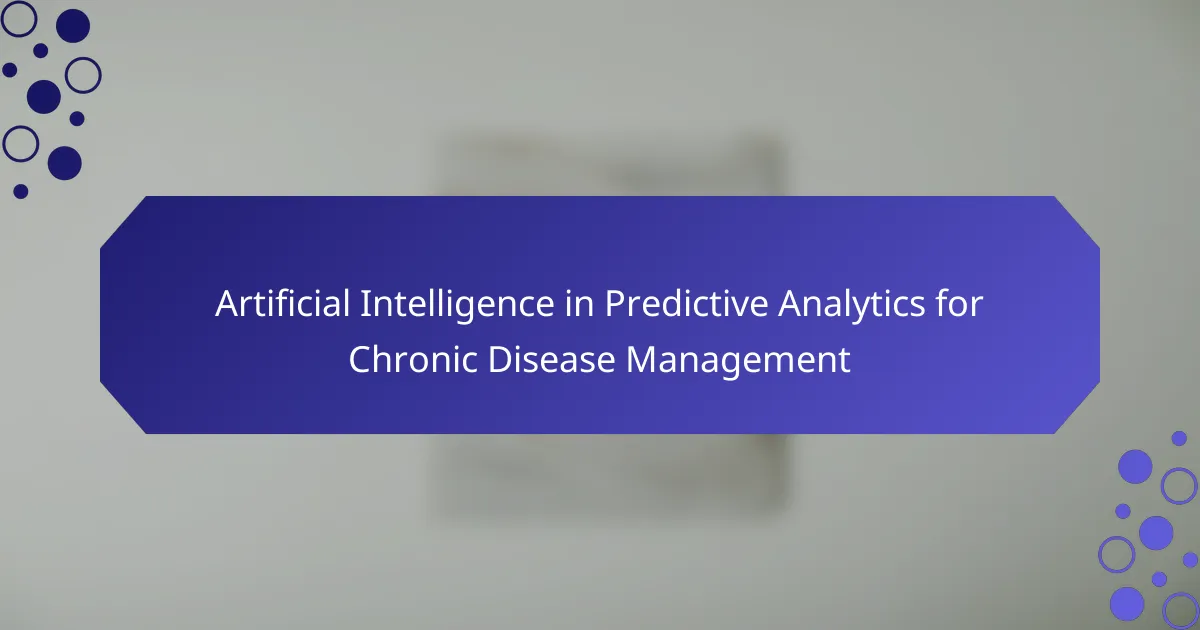Artificial Intelligence is transforming chronic disease management through predictive analytics by improving accuracy and efficiency. It enables early detection of disease patterns, real-time monitoring of patient data, and personalised treatment plans. AI-driven tools enhance patient engagement and optimise healthcare resource allocation. This article explores the technologies behind AI in predictive analytics, the implementation challenges faced by healthcare organisations, and the significant outcomes achieved through case studies.
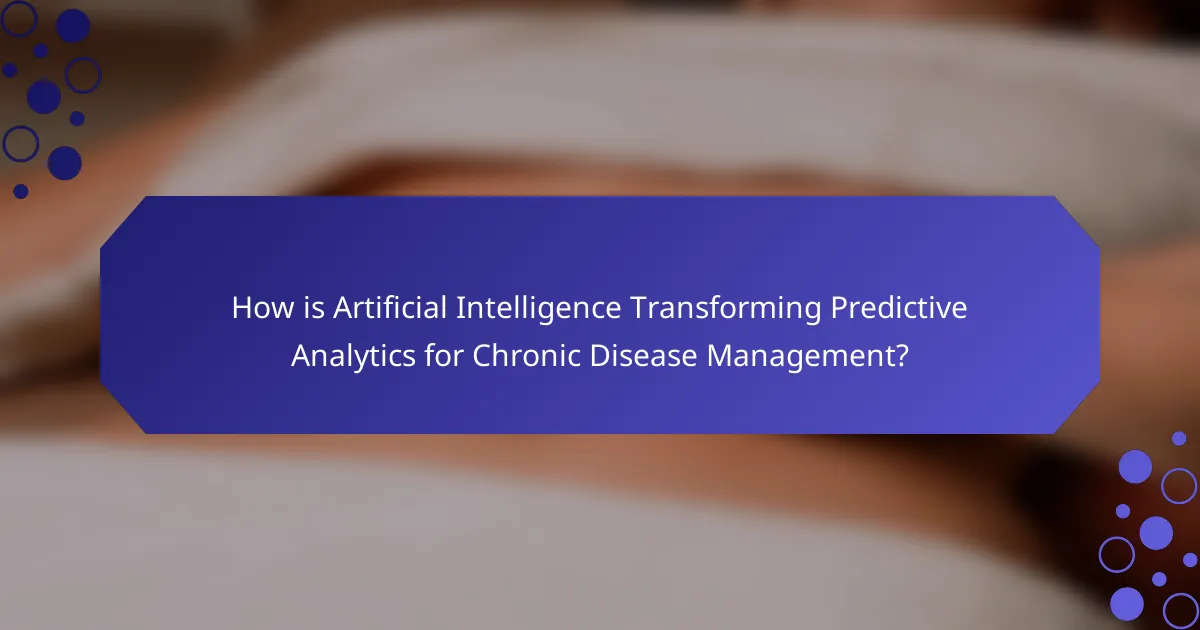
How is Artificial Intelligence Transforming Predictive Analytics for Chronic Disease Management?
Artificial intelligence is revolutionising predictive analytics for chronic disease management by enhancing accuracy and efficiency. AI algorithms analyse vast datasets to identify patterns and predict disease progression, leading to personalised treatment plans.
AI-driven tools enable real-time monitoring of patient data, allowing for timely interventions. For instance, machine learning models can forecast complications in diabetes patients, improving outcomes through proactive care.
Moreover, AI enhances patient engagement by providing tailored health recommendations based on individual risk factors. This personalised approach fosters better adherence to treatment protocols, ultimately reducing hospitalisations.
The integration of AI in predictive analytics represents a unique advancement in chronic disease management, offering significant potential to transform healthcare delivery.
What are the Key Benefits of Using AI in Predictive Analytics?
Artificial Intelligence significantly enhances predictive analytics for chronic disease management by improving accuracy, efficiency, and patient outcomes. It analyses vast datasets to identify patterns and predict disease progression.
AI algorithms can process real-time data, enabling timely interventions and personalised treatment plans. For example, machine learning models can forecast potential complications, allowing healthcare providers to take proactive measures.
Moreover, AI reduces administrative burdens, streamlining workflows and freeing up resources for patient care. This leads to a more effective healthcare system that prioritises patient well-being and optimises resource allocation.
Ultimately, the integration of AI in predictive analytics not only supports clinicians but also empowers patients by providing tailored health insights and fostering better disease management practices.
Which Chronic Diseases Can Benefit Most from Predictive Analytics?
Chronic diseases that benefit most from predictive analytics include diabetes, cardiovascular diseases, chronic respiratory diseases, and obesity. These conditions can leverage AI to improve patient outcomes and optimise treatment plans. Predictive analytics helps identify risk factors, monitor disease progression, and personalise interventions. For instance, diabetes management can be enhanced by predicting blood sugar fluctuations, leading to timely adjustments in medication.

What Technologies Underpin AI in Predictive Analytics?
Artificial intelligence in predictive analytics utilises various technologies, including machine learning, natural language processing, and data mining. Machine learning algorithms identify patterns in health data, enabling early disease detection. Natural language processing assists in analysing unstructured data, such as patient reports, enhancing predictive accuracy. Data mining techniques extract valuable insights from large datasets, improving chronic disease management strategies. These technologies collectively empower healthcare providers to make informed decisions and tailor interventions for better patient outcomes.
How Do Machine Learning Algorithms Enhance Predictive Models?
Machine learning algorithms significantly enhance predictive models by improving accuracy and efficiency. They analyse vast datasets to identify patterns, enabling early detection of chronic diseases. These algorithms adapt over time, refining predictions as new data becomes available. For instance, techniques like regression analysis and neural networks provide insights into patient outcomes, optimising treatment plans.
What Role Does Big Data Play in Chronic Disease Management?
Big data significantly enhances chronic disease management through predictive analytics. It enables healthcare providers to identify at-risk patients, optimise treatment plans, and improve patient outcomes. By analysing vast datasets, AI algorithms can detect patterns and trends that inform early interventions. For instance, predictive models can forecast disease progression based on historical health data, lifestyle factors, and genetic information. This proactive approach allows for personalised care strategies, ultimately reducing healthcare costs and improving quality of life for patients with chronic conditions.
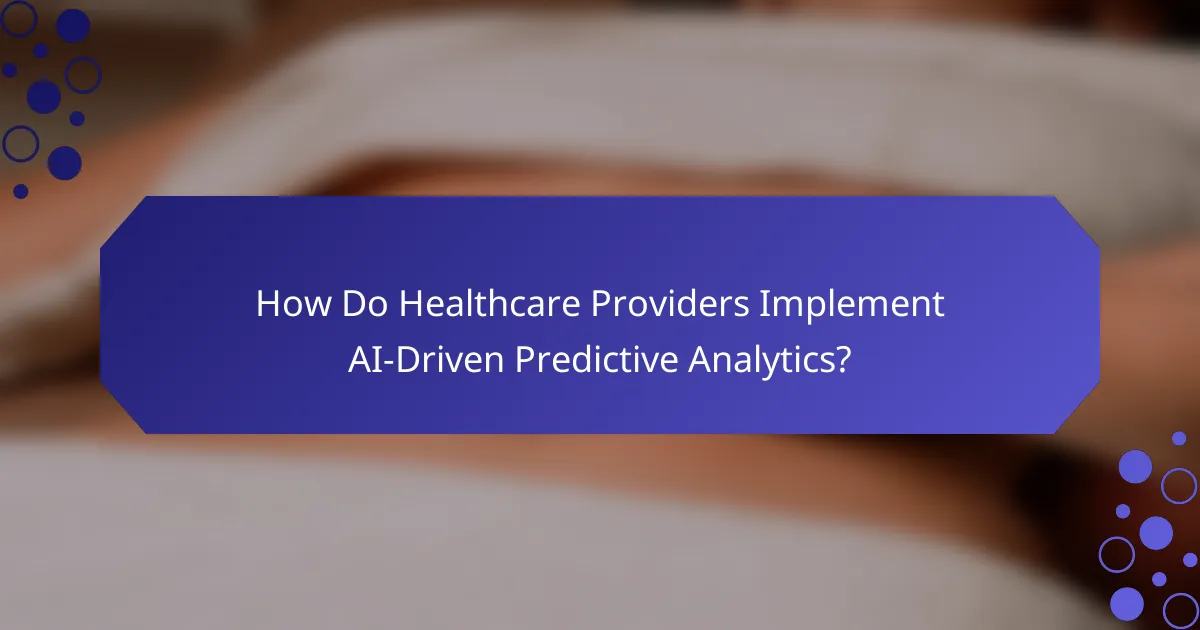
How Do Healthcare Providers Implement AI-Driven Predictive Analytics?
Healthcare providers implement AI-driven predictive analytics by integrating data from various sources, analysing patient histories, and identifying risk factors. This approach enhances chronic disease management by predicting patient outcomes and personalising treatment plans.
Key steps include data collection, algorithm development, and validation of predictive models. For instance, machine learning algorithms can analyse large datasets to identify patterns in patient behaviour and disease progression. As a result, healthcare providers can intervene early, improving patient outcomes and reducing healthcare costs.
AI-driven predictive analytics also supports remote monitoring, enabling continuous assessment of patient health. This capability allows for timely adjustments in treatment based on real-time data. Overall, the integration of AI in predictive analytics is transforming chronic disease management through proactive and personalised care strategies.
What Steps Are Involved in Integrating AI Solutions into Existing Systems?
Integrating AI solutions into existing systems involves several key steps. First, assess the current infrastructure to identify compatibility with AI technologies. Next, define specific goals for AI implementation, focusing on predictive analytics for chronic disease management. Then, select appropriate AI tools and platforms that align with these objectives. Following this, ensure data quality and accessibility, as accurate data is crucial for effective predictive analytics. Finally, conduct thorough testing and training to ensure smooth integration and user adaptation.
Which Stakeholders Are Essential for Successful Implementation?
Key stakeholders for successful implementation of artificial intelligence in predictive analytics for chronic disease management include healthcare providers, data scientists, IT professionals, patients, and regulatory bodies. Each stakeholder plays a vital role in ensuring effective integration and utilisation of AI technologies.
Healthcare providers offer insights into clinical needs and workflows. Data scientists analyse data patterns and develop predictive models. IT professionals ensure the infrastructure supports AI systems. Patients provide feedback on usability and outcomes. Regulatory bodies establish guidelines to ensure compliance and safety.
Collaboration among these stakeholders enhances the potential for improved patient outcomes and streamlined processes in chronic disease management.
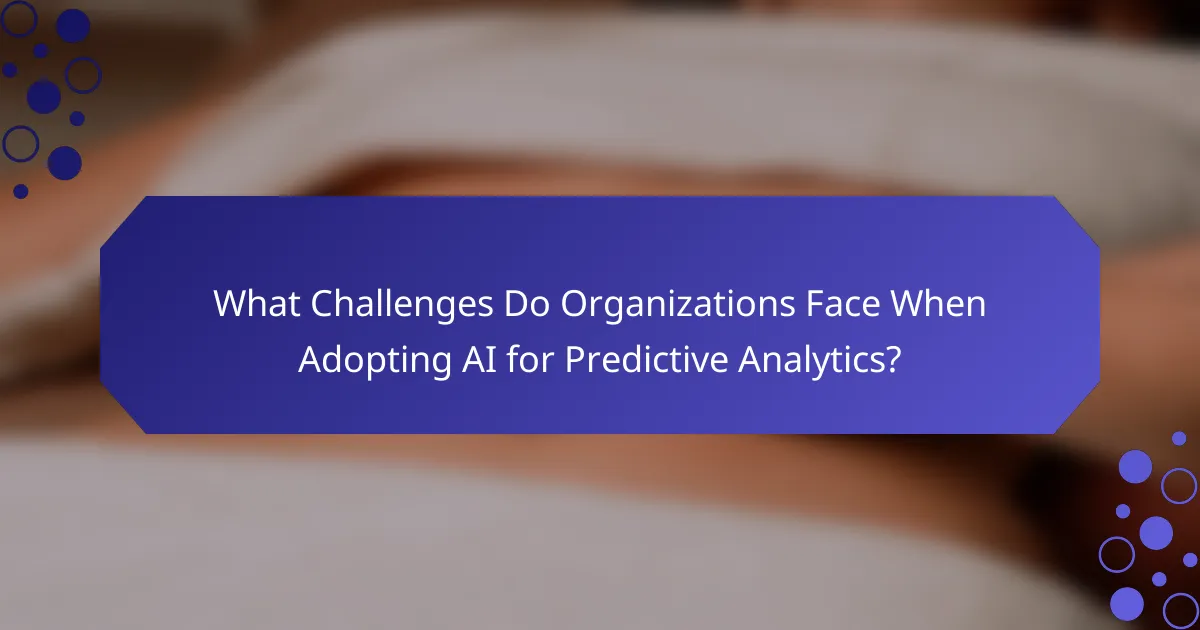
What Challenges Do Organizations Face When Adopting AI for Predictive Analytics?
Organisations face several challenges when adopting AI for predictive analytics in chronic disease management. Key issues include data quality, integration complexities, and the need for skilled personnel.
Data quality is crucial; incomplete or inaccurate data can lead to ineffective predictions. Integration of AI systems with existing healthcare infrastructure poses technical difficulties, often requiring significant investments. Additionally, there is a shortage of data scientists and AI specialists who understand both the technology and healthcare specifics, hindering effective implementation.
Ensuring compliance with regulations and ethical considerations adds another layer of complexity. Organisations must navigate privacy laws while leveraging patient data for predictive analytics.
Finally, resistance to change within the workforce can impede the adoption process. Stakeholders may be hesitant to trust AI-driven insights over traditional methods, impacting the overall effectiveness of AI initiatives in chronic disease management.
How Can Data Privacy Concerns Impact AI Adoption?
Data privacy concerns can significantly hinder AI adoption in predictive analytics for chronic disease management. Organisations fear potential data breaches and misuse of sensitive health information. Compliance with regulations such as GDPR and HIPAA complicates data handling, leading to cautious approaches in AI implementation. As a result, many healthcare providers may delay or limit their use of AI technologies, impacting the potential benefits of improved patient outcomes and efficient resource allocation.
What Are Common Technical Barriers in Implementation?
Common technical barriers in implementing artificial intelligence in predictive analytics for chronic disease management include data quality issues, integration challenges, algorithm bias, and regulatory compliance. Data quality is crucial; incomplete or inaccurate data can lead to unreliable predictions. Integration with existing healthcare systems often faces compatibility issues, hindering seamless data flow. Algorithm bias can result from unrepresentative training data, impacting fairness and effectiveness. Lastly, regulatory compliance poses challenges, as healthcare organisations must navigate complex legal requirements while deploying AI solutions.

What Unique Case Studies Highlight the Effectiveness of AI in Chronic Disease Management?
AI has demonstrated significant effectiveness in chronic disease management through various case studies. For instance, a study showed that AI algorithms improved early detection of diabetes by analysing patient data patterns, leading to a 30% reduction in complications. Another example involved the use of machine learning to predict heart failure events, resulting in a 25% decrease in hospital readmissions. Furthermore, AI-driven personalised treatment plans have enhanced patient adherence, showing a 40% improvement in chronic disease outcomes. These unique case studies highlight AI’s transformative role in predictive analytics, ultimately benefiting patient health.
How Have Specific Health Systems Achieved Success with AI Solutions?
Health systems have successfully integrated AI solutions in predictive analytics for chronic disease management by leveraging data-driven insights to enhance patient care. They utilise algorithms to analyse patient data, predict disease progression, and tailor interventions.
For instance, systems like the Mayo Clinic employ AI to identify patients at risk for conditions such as diabetes and heart disease. This proactive approach allows for early intervention, reducing hospital admissions and improving patient outcomes.
A significant benefit is the ability to process vast amounts of data quickly, enabling timely decision-making. As a result, healthcare providers can optimise resource allocation and improve treatment effectiveness.
Overall, the application of AI in predictive analytics has transformed chronic disease management, leading to better health outcomes and more efficient healthcare delivery.
What Lessons Can Be Learned from Failed Implementations?
Failed implementations of artificial intelligence in predictive analytics for chronic disease management highlight critical lessons. Key insights include the necessity of clear objectives, robust data quality, and stakeholder engagement.
Firstly, defining clear objectives is essential. Without precise goals, projects can drift, leading to misaligned expectations and ineffective outcomes.
Secondly, data quality significantly impacts the effectiveness of AI models. Inaccurate or incomplete data can produce misleading predictions, undermining trust in the system.
Lastly, engaging stakeholders throughout the process ensures that the technology meets user needs and integrates smoothly into existing workflows. This collaboration fosters acceptance and enhances the likelihood of successful implementation.
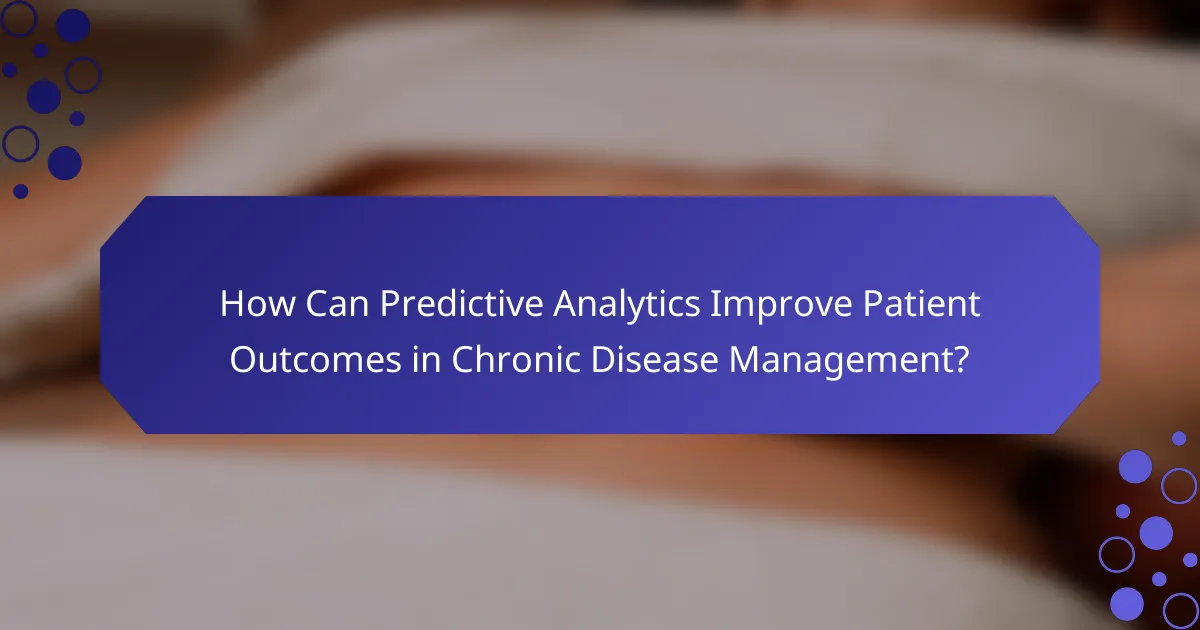
How Can Predictive Analytics Improve Patient Outcomes in Chronic Disease Management?
Predictive analytics can significantly enhance patient outcomes in chronic disease management by leveraging artificial intelligence. It identifies patterns in patient data, enabling personalised treatment plans and timely interventions. This proactive approach reduces hospital admissions and improves overall health metrics.
AI-driven predictive models analyse various data sources, including electronic health records and wearables. For example, they can predict exacerbations in conditions like diabetes or heart disease, allowing healthcare providers to act before complications arise. This capability not only improves patient satisfaction but also optimises resource allocation in healthcare settings.
Moreover, predictive analytics fosters patient engagement through tailored communication strategies. By providing patients with insights into their health risks, they are more likely to adhere to treatment plans. This engagement is crucial in managing chronic diseases effectively.
In conclusion, the integration of predictive analytics in chronic disease management leads to improved outcomes by enabling early intervention, enhancing patient engagement, and optimising healthcare resources.
What Metrics Are Used to Measure Success in Patient Care?
Key metrics for measuring success in patient care using artificial intelligence in predictive analytics include patient outcomes, readmission rates, patient satisfaction scores, and cost-effectiveness. These metrics help assess the effectiveness of chronic disease management strategies.
| Metric | Description |
|————————-|————————————————–|
| Patient Outcomes | Improvement in health status and quality of life |
| Readmission Rates | Frequency of patients returning for the same issue|
| Patient Satisfaction | Feedback on care experience and service quality |
| Cost-Effectiveness | Financial efficiency of interventions |
How Does Predictive Analytics Facilitate Personalized Treatment Plans?
Predictive analytics enhances personalised treatment plans by analysing patient data to identify specific health patterns. This approach tailors interventions based on individual risk factors, improving outcomes for chronic disease management. For example, AI algorithms can predict disease progression, allowing healthcare providers to adjust treatment strategies proactively. This data-driven personalisation leads to more effective management and better patient adherence to treatment protocols. As a result, predictive analytics significantly contributes to optimising healthcare delivery and enhancing patient quality of life.

What Future Trends Are Emerging in AI and Predictive Analytics?
Artificial Intelligence is increasingly shaping predictive analytics for chronic disease management by enhancing accuracy and efficiency. Emerging trends include the integration of machine learning algorithms to analyse vast datasets, enabling early detection of disease patterns. Additionally, real-time data processing through wearable devices allows for continuous monitoring and personalised interventions. The use of natural language processing enhances patient communication by analysing feedback and symptoms. Lastly, ethical AI frameworks are being developed to ensure responsible data usage and patient privacy.
How Will Advances in AI Change the Landscape of Chronic Disease Management?
Advances in AI will significantly enhance chronic disease management by improving predictive analytics. AI algorithms can analyse vast datasets to identify patterns and predict disease progression, enabling timely interventions. This proactive approach can lead to better patient outcomes and reduced healthcare costs. For instance, AI can forecast diabetes complications by analysing patient history and lifestyle factors, allowing for personalised treatment plans. As a result, healthcare providers can shift from reactive care to preventive strategies, ultimately transforming chronic disease management.
What Innovations Are on the Horizon for Predictive Analytics Technologies?
Artificial intelligence is set to revolutionise predictive analytics in chronic disease management through advanced algorithms and real-time data processing. Innovations include enhanced machine learning models that improve accuracy in risk prediction, enabling personalised treatment plans. Additionally, integration with wearable technology allows continuous monitoring of patient health metrics, facilitating timely interventions. The use of natural language processing enhances data interpretation from diverse sources, such as electronic health records, improving decision-making processes. These advancements aim to optimise patient outcomes and reduce healthcare costs significantly.
What Best Practices Should Organizations Follow When Implementing AI Solutions?
Organisations should prioritise data quality, stakeholder engagement, and iterative testing when implementing AI solutions. Ensuring high-quality data enhances predictive accuracy in chronic disease management. Engaging stakeholders fosters collaboration and addresses concerns, promoting acceptance. Iterative testing allows for continuous improvement, adapting AI models to evolving healthcare needs. Emphasising these best practices leads to effective AI integration and better patient outcomes.
